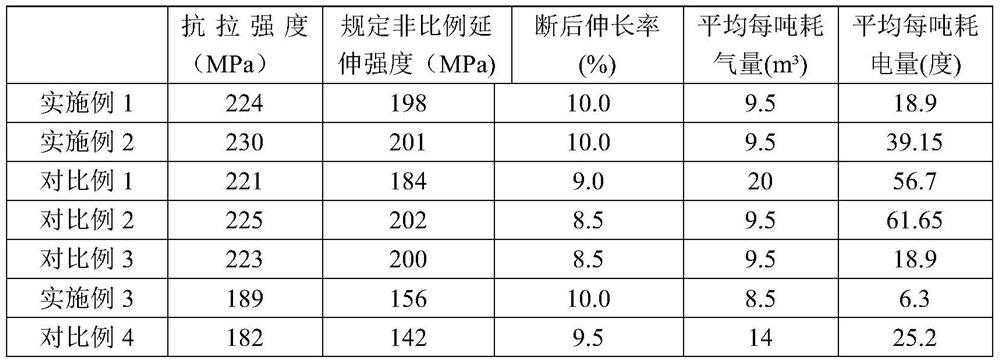A 6××× series aluminum alloy aging heat treatment process
An aging heat treatment, aluminum alloy technology, applied in the field of material processing, can solve the problems of small scope, high natural gas consumption and power consumption, long preparation time, etc., to achieve the effect of large strength and elongation, reduced power consumption, and large number density
- Summary
- Abstract
- Description
- Claims
- Application Information
AI Technical Summary
Problems solved by technology
Method used
Image
Examples
Embodiment 1
[0043] A 6××× series aluminum alloy material, the alloy material includes the following chemical components and their respective mass percentages: Mg 0.55-0.62%, Si 0.38-0.42%, Cu<0.005%, Mn<0.005%, Cr< 0.005%, Zn<0.005%, Ti 0.015-0.02%, in line with the composition range of 6063 in the national standard GB / T3190-2008.
[0044] The aluminum alloy materials configured according to the above-mentioned composition and percentage content are successively subjected to melting and casting, homogenization annealing, extrusion or rolling, solid solution or online quenching and aging heat treatment, among which the T6 aging heat treatment process is: the online quenching temperature is 535 ℃ and use "water spray + strong wind" to cool to the surface temperature below 150 ℃. The aluminum alloy profiles treated are heated to 190 ℃ in the aging furnace. After the temperature is 160°C, it is taken out of the furnace (in this aging furnace, the cooling rate is 8°C / h), and then the aluminum ...
Embodiment 2
[0046]A 6××× series aluminum alloy material, the alloy material includes the following chemical components and their respective mass percentages: Mg 0.55-0.62%, Si 0.38-0.42%, Cu<0.005%, Mn<0.005%, Cr< 0.005%, Zn<0.005%, Ti 0.015-0.02%, in line with the composition range of 6063 in the national standard GB / T3190-2008.
[0047] The aluminum alloy materials configured according to the above-mentioned composition and percentage content are successively subjected to melting and casting, homogenization annealing, extrusion or rolling, solid solution or online quenching and aging heat treatment, among which the T6 aging heat treatment process is: the online quenching temperature is 535 ℃ and use "water spray + strong wind" to cool the aluminum profile to a surface temperature below 150 ℃ (consistent with the quenching and cooling speed in Example 1) in the aging furnace and heat it to 190 ℃, after holding for 2 hours, control the aluminum alloy in the aging furnace The cooling rate ...
Embodiment 3
[0058] A 6××× series aluminum alloy material, the alloy material includes the following chemical components and their respective mass percentages: Mg 0.55-0.62%, Si 0.38-0.42%, Cu<0.005%, Mn<0.005%, Cr< 0.005%, Zn<0.005%, Ti 0.015-0.02%, in line with the composition range of 6063 in the national standard GB / T3190-2008.
[0059] The aluminum alloy materials configured according to the above-mentioned composition and percentage content are successively subjected to melting and casting, homogenization annealing, extrusion or rolling, solid solution or online quenching and aging heat treatment, wherein the T5 aging heat treatment process is: the online quenching temperature is 535 ℃ and use "water spray + strong wind" to cool to below 150 ℃ (consistent with the quenching and cooling speed of Example 1) in the aging furnace and heat to 200 ℃, after 0h of heat preservation, turn off the burner and the circulating fan (the aging The measured natural cooling rate of the furnace is 10°...
PUM
| Property | Measurement | Unit |
|---|---|---|
| tensile strength | aaaaa | aaaaa |
Abstract
Description
Claims
Application Information
 Login to View More
Login to View More - R&D
- Intellectual Property
- Life Sciences
- Materials
- Tech Scout
- Unparalleled Data Quality
- Higher Quality Content
- 60% Fewer Hallucinations
Browse by: Latest US Patents, China's latest patents, Technical Efficacy Thesaurus, Application Domain, Technology Topic, Popular Technical Reports.
© 2025 PatSnap. All rights reserved.Legal|Privacy policy|Modern Slavery Act Transparency Statement|Sitemap|About US| Contact US: help@patsnap.com



